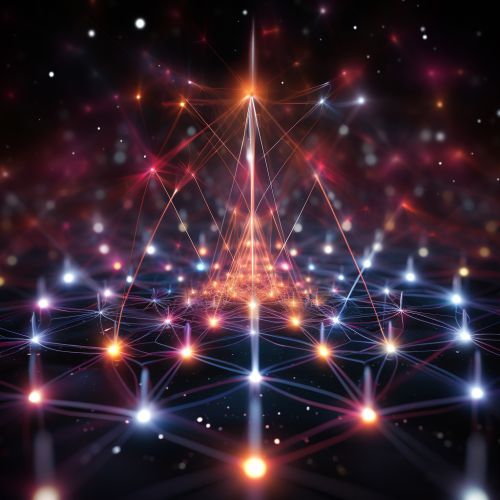Quantum State Transfer in Quantum Networks
Introduction
Quantum state transfer is a fundamental process in quantum networks, which are systems of interconnected quantum computers or quantum nodes. The process involves the transmission of quantum information from one node to another within the network. This is achieved through the manipulation of quantum entanglement and quantum superposition principles, which are key characteristics of quantum mechanics.


Quantum State
A quantum state is a mathematical entity that provides a probability distribution for the outcomes of each possible measurement on a system. In quantum mechanics, unlike classical mechanics, the state of a system at a given time is described by a complex wave function, also known as a state vector in a complex vector space. This state vector represents the probabilities of the outcomes of any measurement performed on the system.
Quantum Networks
Quantum networks are systems of interconnected quantum nodes or quantum computers. These networks are designed to allow for the transfer of quantum information between nodes. This is achieved through the use of quantum channels, which are physical mediums that can carry quantum information. Quantum networks have the potential to revolutionize information technology by enabling secure communication, efficient computation, and precise sensing.
Quantum State Transfer
Quantum state transfer is the process of transmitting a quantum state from one node to another within a quantum network. This process is fundamental to the operation of quantum networks, as it enables the transmission of quantum information across the network. Quantum state transfer is achieved through the use of quantum channels and the manipulation of quantum entanglement and quantum superposition.
Quantum Channels
A quantum channel is a communication medium that can transmit quantum information. Quantum channels are characterized by their ability to preserve the quantum properties of the information they carry, such as superposition and entanglement. This is in contrast to classical communication channels, which can only transmit classical information.
Quantum Entanglement
Quantum entanglement is a physical phenomenon that occurs when a pair or group of particles interact in ways such that the quantum state of each particle cannot be described independently of the state of the others. This phenomenon is used in quantum networks to enable the transfer of quantum states between nodes.
Quantum Superposition
Quantum superposition is a fundamental principle of quantum mechanics that states that any two (or more) quantum states can be added together, or "superposed", and the result will be another valid quantum state. This principle is used in quantum state transfer to manipulate the states of the nodes in the network.
Quantum State Transfer in Quantum Networks
In a quantum network, quantum state transfer is achieved by first entangling the states of the nodes. This is done by performing a quantum operation on the nodes that results in a joint state that is a superposition of the individual states. Once the nodes are entangled, a quantum state can be transferred from one node to another by performing a measurement on the first node and using the result to manipulate the state of the second node.
